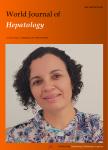Late polymicrobial transjugular intrahepatic portosystemic shunt infection in a liver transplant patient:A case report
作者机构:Department of MedicineUniversity of Virginia Medical CenterCharlottesvilleVA 22903United States Department of Radiology and Medical ImagingDivision of Vascular and Interventional RadiologyUniversity of Virginia Medical CenterCharlottesvilleVA 22903United States Department of MedicineDivision of Infectious Diseases and International HealthUniversity of Virginia Medical CenterCharlottesvilleVA 22903United States Department of MedicineDivision of Gastroenterology and HepatologyUniversity of Virginia Medical CenterCharlottesvilleVA 22903United States
出 版 物:《World Journal of Hepatology》 (世界肝病学杂志(英文版)(电子版))
年 卷 期:2022年第14卷第4期
页 面:846-853页
主 题:Transjugular intrahepatic portosystemic shunt Endotipsitis Colitis Liver cirrhosis Liver transplantation Case report
摘 要:BACKGROUND Infection of a transjugular intrahepatic portosystemic shunt(TIPS)stent is a rare and serious complication that most commonly occurs during TIPS creation and revision.Patients typically present with recurrent bacteremia due to shunt occlusion or vegetation.To date there are approximately 58 cases reported.We present a patient diagnosed with late polymicrobial TIPS infection five years following TIPS creation.CASE SUMMARY A 63-year-old female status-post liver transplant with recurrent cirrhosis and portal hypertension presented with sepsis and recurrent extended-spectrum betalactamase Escherichia coli bacteremia.Computed tomography of the abdomen revealed an occluded TIPS with thrombus extension into the distal right portal vein,and focal thickening of the cecum and ascending colon.Colonoscopy revealed patchy ulcers in these areas with histopathology demonstrating ulcerated colonic mucosa with fibrinopurulent exudate.Shunt thrombectomy and revision revealed infected-appearing thrombus.Patient initially cleared her infection with antibacterial therapy and TIPS revision;however,soon after,she developed Enterobacter cloacae bacteremia and Candida glabrata and C.albicans fungemia with recurrent TIPS thrombosis.She remained on antifungal therapy indefinitely and later developed vancomycin-resistant Enterococcus faecium with recurrent TIPS thrombosis.The option of liver re-transplant for removal of the infected TIPS was not offered given her critical illness and complex shunt anatomy.The patient became intolerant to linezolid and elected hospice care.CONCLUSION Clinicians should be aware that TIPS superinfection may occur as long as five years following TIPS creation in an immunocompromised patient.



